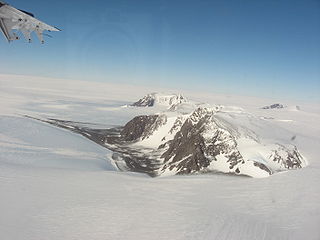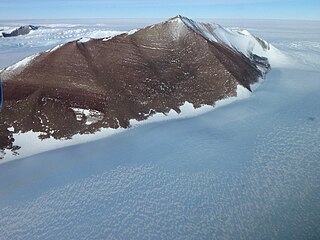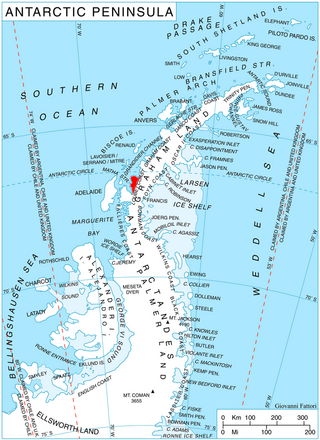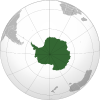Related Research Articles

The Thiel Mountains are isolated, mainly snow-capped mountains of the Transantarctic Mountains System, located in the Ellsworth Land region of Antarctica. The mountain range is 45 nautical miles long, is located roughly between the Horlick Mountains and the Pensacola Mountains, and extends from Moulton Escarpment on the west to Nolan Pillar on the east. Major components include Ford Massif, Bermel Escarpment and a group of eastern peaks near Nolan Pillar.

The Pensacola Mountains are a large group of mountain ranges and peaks that extend 280 nautical miles in a northeast–southwest direction in the Transantarctic Mountains System, Queen Elizabeth Land region of Antarctica. They comprise the Argentina Range, Forrestal Range, Dufek Massif, Cordiner Peaks, Neptune Range, Patuxent Range, Rambo Nunataks and Pecora Escarpment. These mountain units lie astride the extensive Foundation Ice Stream and Support Force Glacier which drain northward to the Ronne Ice Shelf.
Hansen Mountains is a large group of nunataks rising to about 300 m (980 ft) above the Antarctic plateau. The mountains are approximately 89 km (55 mi) south of Stefansson Bay and they extend 40 km (25 mi) from northwest to southeast in Kemp Land, East Antarctica. The Hansen Mountains were first mapped by Norwegian cartographers from air photos taken by the 1936–1937 Lars Christensen Expedition. They were named for H.E. Hansen, the Norwegian cartographer who compiled the maps for this and other Norwegian Antarctic expeditions.
The Scott Mountains are a large number of isolated peaks lying south of Amundsen Bay in Enderby Land of East Antarctica, Antarctica. Discovered on 13 January 1930 by the British Australian New Zealand Antarctic Research Expedition (BANZARE) under Sir Douglas Mawson. He named the feature Scott Range after Captain Robert Falcon Scott, Royal Navy. The term mountains is considered more appropriate because of the isolation of its individual features.
Mount Bird is a 1,765 metres (5,791 ft) high shield volcano standing about 7 nautical miles south of Cape Bird, the northern extremity of Ross Island. It was mapped by the British National Antarctic Expedition, 1901–04, under Robert Falcon Scott, and apparently named by them after Cape Bird.
The Bermel Escarpment is a snow and rock escarpment, 15 nautical miles long, extending from the base of the Ford Massif to King Peak, in the Thiel Mountains of Antarctica. The escarpment drops 300 to 400 metres from the Antarctic Plateau to the ice surface north of these mountains.
Buggisch Peak is a peak rising to 1,445 metres (4,740 ft), 1 nautical mile (2 km) southwest of Lester Peak, Edson Hills, in the Heritage Range, Ellsworth Mountains, Marie Byrd Land. It was mapped by the United States Geological Survey from surveys and from U.S. Navy aerial photographs, 1961–66, and named by the Advisory Committee on Antarctic Names after Werner Buggisch, a German member of the field party with the United States Antarctic Research Program Ellsworth Mountains Expedition, 1979–80, led by Gerald F. Webers.
The Darley Hills are a range of high, ice-covered coastal hills in the Churchill Mountains, Antarctica.
Kosco Peak is a prominent rock peak in the northern part of the Edson Hills, rising to about 1,650 metres (5,400 ft) between Drake Icefall and Hyde Glacier, in the Heritage Range, Ellsworth Mountains, Antarctica. It was mapped by the United States Geological Survey (USGS) from surveys and U.S. Navy aerial photographs from 1961 to 1966, and was named by the Advisory Committee on Antarctic Names after William J. Kosco. Kosco was a topographic engineer at the USGS from 1952 to 1983 and was chief of the Polar Programs Office from 1975 to 1983, with responsibility for Antarctic mapping.
Pioneer Heights is a group name in the Heritage Range, Ellsworth Mountains, encompassing the large area of hills, ridges and peaks located eastward of Schneider and Schanz Glaciers and between Splettstoesser and Union Glaciers. Among these features are the Inferno Ridge, the Nimbus Hills, Gross, Buchanan and Collier Hills. The Pioneer Heights were mapped by the United States Geological Survey (USGS) from ground surveys and U.S. Navy air photos from 1961 to 1966. The name was applied by the Advisory Committee on Antarctic Names (US-ACAN) in association with the name Heritage Range.
Elvers Peak is a peak, 1,615 metres (5,300 ft) high, at the southeast end of the Edson Hills in the Heritage Range, Antarctica. It was mapped by the United States Geological Survey from surveys and U.S. Navy air photos, 1961–66, and was named by the Advisory Committee on Antarctic Names for Douglas J. Elvers, a seismologist on the United States Antarctic Research Program South Pole—Queen Maud Land Traverse II, in 1965–66.
Gambacorta Peak is a peak 1,840 metres (6,040 ft) high, standing 4 nautical miles east of Mount Kaschak in the southern Neptune Range, Pensacola Mountains, Antarctica.

McCance Glacier is the 30-km long and 5 km wide glacier draining the Hutchison Hill area on the west slopes of Avery Plateau on Loubet Coast in Graham Land, Antarctica. It flows north-northwestwards along the west side of Osikovo Ridge, Kladnitsa Peak and Rubner Peak and enters Darbel Bay.

The Holth Peaks are a group of peaks which rise to 1,820 metres (5,970 ft) in the form of a short northeast–southwest ridge, 2 nautical miles (4 km) northwest of Mount Lymburner near the northern end of the Sentinel Range in the Ellsworth Mountains of Antarctica. They were discovered by Lincoln Ellsworth on his trans-Antarctic flight of November 23, 1935, and were named by the Advisory Committee on Antarctic Names for Baard Holth, captain of the MV Wyatt Earp on Ellsworth's first expedition to Antarctica in 1933–34.
Lester Peak is a prominent snow-free peak at the south side of Hyde Glacier 1 nautical mile (2 km) northeast of Buggisch Peak in the Edson Hills of the Heritage Range, Marie Byrd Land, Antarctica. It was mapped by the United States Geological Survey from surveys and U.S. Navy air photos from 1961 to 1966, and was named by the Advisory Committee on Antarctic Names for Lester A. Johnson, a meteorologist at Little America V Station in 1958.

Kornicker Glacier is a glacier draining northeastwards from the cirque bounded by Mount Liptak, Mount Southwick, Mount Milton and Mount Mullen in the southern Sentinel Range of the Ellsworth Mountains in Antarctica. The glacier flows along the northwestern side of Petvar Heights and merges with the terminus of the southeast-flowing Thomas Glacier as both glaciers emerge from the range.

Bender Glacier is a glacier that flows from Mount Atkinson and Mount Craddock southwards between Chaplin Peak and Krusha Peak, and joins Nimitz Glacier just south of Gilbert Spur in the southern Sentinel Range, Ellsworth Mountains in Antarctica. Receiving ice influx from its left tributaries Severinghaus Glacier, Brook Glacier and Bolgrad Glacier.

Fukushima Peak is a high, pointed rocky peak, 4,634 metres (15,203 ft) high, near the south edge of the ice-covered Vinson Plateau in the Sentinel Range of the Ellsworth Mountains, Antarctica.

Mount Warren is a mountain rising to 2,340 metres (7,680 ft) in Gromshin Heights, just north of the turn in Newcomer Glacier on the east side of northern Sentinel Range in Ellsworth Mountains, Antarctica. It surmounts Newcomer Glacier to the west and south, and Vicha Glacier to the northeast.
References
- ↑ "Johnson Peak". Geographic Names Information System . United States Geological Survey, United States Department of the Interior . Retrieved 27 July 2012.
![]() This article incorporates public domain material from "Johnson Peak (Antarctica)". Geographic Names Information System . United States Geological Survey.
This article incorporates public domain material from "Johnson Peak (Antarctica)". Geographic Names Information System . United States Geological Survey.
